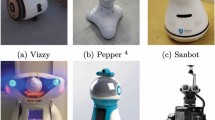Abstract
Individuality is one of the most important qualities of humans. Social robots should be able to model the individuality of the human partners and to modify their behaviours accordingly.This paper proposes a profiling system for social robots to be able to learn the individuality of human partners in social contexts. Profiles are expressed in terms of of identities and preferences bound together. In particular, people’s identity is captured by the use of facial features, while preferences are extracted from the discussion between the partners. Both are bound using an Hebb network. Experiments show the feasibility and the performances of the approach presented.
Access this chapter
Tax calculation will be finalised at checkout
Purchases are for personal use only
Preview
Unable to display preview. Download preview PDF.
Similar content being viewed by others
References
Breazeal, C.: Toward sociable robots. Robotics and Autonomous Systems 42(3-4) (2003)
Breazeal, C.L.: Designing sociable robots. The MIT Press (2004)
Anzalone, S., Nuzzo, A., Patti, N., Sorbello, R., Chella, A.: Emo-dramatic robotic stewards. Social Robotics, 382–391 (2010)
Lee, A., Kawahara, T., Shikano, K.: Julius—an open source real-time large vocabulary recognition engine. In: Seventh European Conference on Speech Communication and Technology (2001)
Anzalone, S.M., Menegatti, E., Pagello, E., Yoshikawa, Y., Ishiguro, H., Chella, A.: Audio-video people recognition system for an intelligent environment. In: 2011 4th International Conference on Human System Interactions (HSI), pp. 237–244. IEEE (2011)
Viola, P., Jones, M.: Robust real-time object detection. International Journal of Computer Vision 57(2), 137–154 (2002)
Turk, M., Pentland, A.: Face recognition using eigenfaces. In: Proc. IEEE Conf. on Computer Vision and Pattern Recognition, vol. 591, pp. 586–591 (1991)
Hurkens, C., Van Iersel, L., Keijsper, J., Kelk, S., Stougie, L., Tromp, J., Dolech, D., Eindhoven, A.: Face Image Database, publicly available for non-commercial use (2008), http://cvc.yale.edu/projects/yalefaces/yalefaces.html
Steinwart, I., Christmann, A.: Support vector machines. Springer (2008)
Kraft, F., Kilgour, K., Saam, R., Stuker, S., Wolfel, M., Asfour, T., Waibel, A.: Towards social integration of humanoid robots by conversational concept learning. In: 2010 10th IEEE-RAS International Conference on Humanoid Robots (Humanoids), pp. 352–357. IEEE (2010)
Anzalone, S.M., Cinquegrani, F., Sorbello, R., Chella, A.: An emotional humanoid partner. Linguistic and Cognitive Approaches To Dialog Agents (LaCATODA 2010) At AISB (2010)
Jackson, P., Moulinier, I.: Natural language processing for online applications: Text retrieval, extraction and categorization, vol. 5. John Benjamins Pub. Co. (2007)
Anzalone, S.M., Yoshikawa, Y., Menegatti, E., Pagello, E., Sorbello, R., Ishiguro, H.: A topic recognition system for real world human-robot conversations. In: IAS 2012, 12th International Conference on Intelligent Autonomous Systems (2012)
Denoyer, L., Gallinari, P.: The Wikipedia XML Corpus. SIGIR Forum (2006)
Coradeschi, S., Saffiotti, A.: An introduction to the anchoring problem. Robotics and Autonomous Systems 43(2-3), 85–96 (2003)
Yoshikawa, Y., Hosoda, K., Asada, M.: Unique association between self-occlusion and double-touching towards binding vision and touch. Neurocomputing 70(13-15), 2234–2244 (2007)
Kobayashi, S., Tamagawa, S., Morita, T., Yamaguchi, T.: Intelligent humanoid robot with japanese wikipedia ontology and robot action ontology. In: Proceedings of the 6th International Conference on Human-Robot Interaction, pp. 417–424. ACM (2011)
Author information
Authors and Affiliations
Editor information
Editors and Affiliations
Rights and permissions
Copyright information
© 2012 Springer-Verlag Berlin Heidelberg
About this paper
Cite this paper
Anzalone, S.M., Yoshikawa, Y., Ishiguro, H., Menegatti, E., Pagello, E., Sorbello, R. (2012). Towards Partners Profiling in Human Robot Interaction Contexts. In: Noda, I., Ando, N., Brugali, D., Kuffner, J.J. (eds) Simulation, Modeling, and Programming for Autonomous Robots. SIMPAR 2012. Lecture Notes in Computer Science(), vol 7628. Springer, Berlin, Heidelberg. https://doi.org/10.1007/978-3-642-34327-8_4
Download citation
DOI: https://doi.org/10.1007/978-3-642-34327-8_4
Publisher Name: Springer, Berlin, Heidelberg
Print ISBN: 978-3-642-34326-1
Online ISBN: 978-3-642-34327-8
eBook Packages: Computer ScienceComputer Science (R0)




